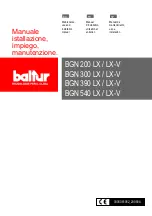
Only the latest issues of above codes should be used, and are
available from either The National Fire Protection Agency, Bat-
terymarch Park, Quincy, MA 02269 or The Canadian Standards
Association, 178 Rexdale Blvd., Rexdale, Ontario M9W 1R3.
Recognize safety information. This is the safety-alert symbol
.
When you see this symbol on the furnace and in instructions or
manuals, be alert to the potential for personal injury.
Understand the signal words DANGER, WARNING, and CAU-
TION. These words are used with the safety-alert symbol. DAN-
GER identifies the most serious hazards which will result in severe
personal injury or death. WARNING signifies a hazard which
could result in personal injury or death. CAUTION is used to
identify unsafe practices which would result in minor personal
injury or product and property damage.
INTRODUCTION
The model 363AAP Furnace is available in 210,000 Btuh input
capacity.
This furnace is a 3-position unit that may be operated in upflow,
horizontal left, or horizontal right airflow positions. Very few
modifications are required to change furnace from 1 position to
another at job site. The furnace is shipped in the upflow configu-
ration. Instructions for changing to other configurations are found
in Changing from Upflow to Horizontal section of these instruc-
tions.
The furnace is shipped as a packaged unit, complete with burner
and controls. It requires a line voltage (115 vac) connection to
control box, a thermostat hook-up as shown on wiring diagram, oil
line connection(s), adequate duct work, and connection to a
properly sized vent.
The air handling capacity of this furnace is designed for cooling
airflow. Refer to Table 3 for expected airflows at various external
duct static pressures.
LOCATION
WARNING:
This furnace is not water tight and is not
designed for outdoor installation. This furnace shall be
installed in such a manner as to protect electrical com-
ponents from water. Outdoor installation would lead to a
hazardous electrical condition and to premature furnace
failure.
WARNING:
Do not use this furnace as a construction
heater. Use of this furnace as a construction heater
exposes furnace to abnormal conditions, contaminated
combustion air, and lack of air filters. Failure to follow
this warning can lead to premature furnace failure and/or
vent failure which could result in a fire hazard and/or
bodily harm.
CAUTION:
For an attic installation, it is important to
keep insulation 12 in. or more away from any furnace
openings. Some types of insulating materials may be
combustible.
This furnace is approved for reduced clearances to combustible
construction, therefore, it may be installed in an alcove or similar
enclosure. It is also approved for attic installation. As this unit may
be installed as an upflow or horizontal furnace, it may be located
in a basement, on the same level as area to be heated, suspended,
or in a crawlspace. In any case, unit should always be installed
level.
In a basement or when installed on the floor (as in a crawlspace),
it is recommended that unit be installed on a concrete pad that is
1- to 2-in. thick.
When installed in horizontal position, furnace may be suspended
by using an angle iron frame, as long as total weight of both
furnace and frame are allowed for in support calculations. Other
methods of suspending are acceptable.
The required minimum clearances for this furnace in all positions
are specified in Table 1.
The furnace should be located as close as possible to chimney or
vent in order to keep vent connections short and direct. The
furnace should also be located as near as possible to center of air
distribution system.
I.
AIR FOR COMBUSTION AND VENTILATION
WARNING:
Installation of this furnace in an area where
it will receive contaminated combustion air must be
avoided. Such contamination would include the follow-
ing: ammonia, chlorine, hydrogen sulfide, halogenated
hydrocarbons, carbon tetrachloride, cleaning solvents,
hydrochloric acid, water softening chemicals, and similar
chemicals. Failure to follow this warning will lead to
premature rusting of heat exchanger and possible prema-
ture furnace failure and/or vent failure which could result
in a fire hazard and/or bodily harm.
This furnace should be installed in a location in which facilities for
ventilation permit satisfactory combustion of oil, proper venting,
and maintenance of ambient temperature at safe limits under
normal conditions of use. The location should not interfere with
proper circulation of air within the confined space. (See NFPA-31
Section 1.5.)
In addition to air needed for combustion, process air shall be
provided as required for: cooling of equipment or material,
controlling dew point, heating, drying, oxidation or dilution, safety
exhaust, and odor control.
In addition to air needed for combustion, air shall be supplied for
ventilation, including all air required for comfort and proper
working conditions for personnel.
The barometric draft regulator (included with furnace) shall be
installed in same room or enclosure as furnace in such a manner as
to prevent any difference in pressure between regulator and
combustion-air supply.
TABLE 1—MINIMUM CLEARANCES TO COMBUSTIBLE
MATERIALS (IN.)
UNIT APPLICATION
UPFLOW HORIZONTAL
Sides
Furnace
2
2
Supply Plenum and Warm-Air
Duct Within 6 ft of Furnace
1
1
Back
2
2
Top
Furnace Casing or Plenum
2
2
Horizontal Warm-Air Duct
Within 6 ft of Furnace
2
3
Bottom
0*
0*
Flue
Pipe
Horizontally or Below Pipe
9
9
Vertically Above Pipe
9
9
Front
24
24
* Floor may be combustible.
NOTE: Adequate service clearance should be provided over and above these
dimensions as required.
—2—
→
→


































